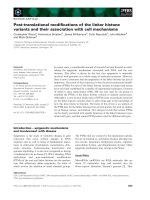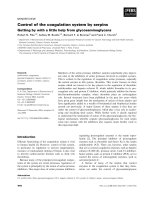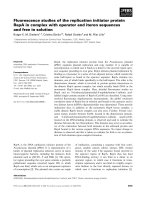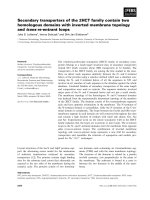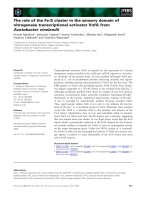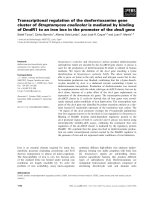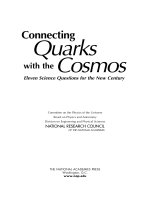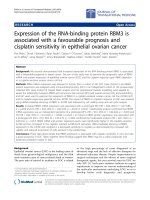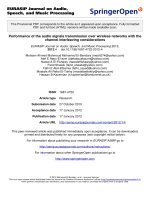Reactivity of the osmium antimony cluster Os3(CO)10(MU H)(MU sbph2) with some group 16 compounds
Bạn đang xem bản rút gọn của tài liệu. Xem và tải ngay bản đầy đủ của tài liệu tại đây (630.38 KB, 62 trang )
REACTIVITY OF THE OSMIUM-ANTIMONY CLUSTER
Os3(CO)10(µ-H)(µ-SbPh2) WITH SOME GROUP 16
COMPOUNDS
TAN WEN LING
B.Sc.(Hons.), UM
A THESIS SUBMITTED
FOR THE DEGREE OF MASTER OF SCIENCE
DEPARTMENT OF CHEMISTRY
NATIONAL UNIVERSITY OF SINGAPORE
2010
Acknowledgements
First of all, I would like to thank my supervisors, A/P Fan Wai Yip, A/P Leong
Weng Kee and A/P Richard Wong Chee Seng for their patient guidance and
invaluable advice throughout the project.
Next, I would like to thank all the members of the groups. In particular, I would
like to express my gratitude to Seah Ling, Kien Voon, Garvin, Xue Ping, Rakesh,
Boon Ying and Kai Ning, for their help, support and fruitful discussions.
I am also grateful to all the staff in the instrument labs for making data acquisition
possible.
Last but not least, I would like to thank my lovely family members for their
prayers and motivation support that made the project complete.
i
TABLE OF CONTENTS
Acknowledgements
i
Table of Contents
ii
Abstract
iv
Molecular Numbering Scheme
v
Abbreviations
xi
List of Tables
xii
List of Figures
xiii
List os Schemes
xiv
Chapter 1: Organometallic chemistry of clusters containing osmium
or ruthenium and the heavier group 15 elements
p.1
1.1. Structural feature
p.2
1.2. Reactivity
p.9
1.3. References
p.13
Chapter 2: Results and discussion
p.16
2.1. Reaction of Os3(CO)10(µ-H)(µ-SbPh2) with REER and PhEH
p.16
2.2. Conclusion
p.27
2.3. References
p.28
Chapter 3: Experimental
p.29
3.1. General experimental
p.29
3.2. Reaction of [PPN][HOs3(CO)11] with (p-tolyl)2SbCl
p.30
3.3. Reaction of 1 or 2 with REER or REH (R = ph, Me; E = S, Se, Te)
p.30
ii
3.4. Reaction of clusters 5
p.33
3.4.1. Thermolysis of 5b
p. 33
3.4.2. Reaction of 5b with PPh3
p.33
3.4.3. Reaction of 5c with bromine
p.34
3.5. Crystallography studies
p.35
3.6. References
p.37
Chapter 4: d-f block organometallic clusters
p.38
4.1. Background
p.38
4.2. Synthetic strategy
p.39
4.3. Synthesis of organometallic clusters containing transition
metal- lanthanide bonds
p.41
4.4. Experimental
p.43
4.4.1. General experimental
p.43
4.4.2. Synthesis of Os3(CO)11L, [L = Ph2P(CH2CH2C9H7),
Ph2P(OC4H3)]
p.44
(a) Synthesis of Os3(CO)11[P(CH2CH2C9H7)Ph2], 13
p.44
(b) Synthesis of Os3(CO)11[P(OC4H3)Ph2], 14
p.44
4.4.3. Reaction of Cp*2Sm(THF)2 with 13 or 14
p.45
(a) Reaction with Os3(CO)11[P(CH2CH2C9H7)Ph2], 13
p.45
(b) Reaction with Os3(CO)11[P(OC4H3)Ph2], 14
p.45
4.4.4. Synthesis of (THF)Yb[(C9H7CH2CH2)PPh2]3, 15
p.45
4.4.5. Reaction of (THF)Yb[(C9H7CH2CH2)PPh2]3 with
Os3(CO)11(NCMe)
p.46
4.5. References
Appendices
p.47
CDROM
iii
ABSTRACT
The reaction of the osmium-antimony cluster Os3(CO)10(µ-H)(µ-SbPh2) with the
group 16 compounds REER or PhEH (R = Ph, Me; E = S, Se, Te) led to the isolation
of the compounds Os3(CO)10(µ-H)(µ-SER) and Os3(CO)10(µ-SbPh2)(µ-EPh).
However, the as-yet unidentified major products were yellow powders which
contained a 2:1 ratio of ER and SbPh2.
iv
MOLECULAR NUMBERING SCHEME
The short line extending from Os (in the molecular structure diagrams) represents a
coordinative bond from carbon monoxide to osmium (Os-CO).
1.
Os3(CO)10(µ-H)(µ-SbPh2)
SbPh2
Os
H
Os
Os
2.
Os3(CO)10(µ-H)[µ-Sb(p-OCH3C6H4)2]
Sb(p-tolyl)2
Os
H
Os
Os
3a.
Os3(CO)10(µ-H)(µ-SPh)
SPh
Os
H
Os
Os
3b.
Os3(CO)10(µ-H)(µ-SePh)
SePh
Os
H
Os
Os
v
3c.
Os3(CO)10(µ-H)(µ-TePh)
TePh
Os
H
Os
Os
4a.
Os3(CO)10(µ-SbPh2) (µ-SPh)
Os
SbPh2
Os
Os
S
Ph
4b.
Os3(CO)10(µ-SbPh2) (µ-SePh)
Os
SbPh2
Os
Se
Ph
Os
5a.
5b.
5c.
Unknown compounds from reaction of 1 or 2 with REER or REH
5d.
(R = Ph, Me, p-tolyl; E = S, Se, Te)
5e.
6.
Unknown compounds from reaction of 5b with PPh3
7.
8.
9.
Unknown compounds from reaction of 5b with bromine
10.
vi
11.
Os3(CO)11(NCCH3)
Os
Os
Os
H3CCN
12.
Cp*2Sm(THF)2
THF
Sm
THF
13.
Os3(CO)11[P(CH2CH2C9H7)Ph2]
Os
Os
Os
14.
P(CH2CH2C9H7)Ph2
Os3(CO)11[P(OC4H3)Ph2]
Os
Os
Os
15.
P(OC4H3)Ph2
(THF)Yb[(C9H7CH2CH2)PPh2]3
Yb O
PPh2 3
vii
16.
Unknown compounds from reaction of 11 with 15
A.
Os3(CO)10(µ-SbPh2)2
Os
SbPh2
Os
Os
Sb
Ph2
B.
[Os3(CO)10(µ-SbPh2)2]2
Ph2
Sb
Os
Os
Os
H
H
Os
Os
Os
Sb
Ph2
C.
HOs3(CO)10(µ-SbPh2)L, L = EPh3, CO or tBuNC
H
Os
Os
SbPh2
Os
L
D.
HOs3(CO)10(µ-SbPh2)L
H
Os
Os
SbPh2
Os
L
viii
E.
HOs3(CO)10(µ-SbPh2)L
H
Os
Os
SbPh2
Os
L
F.
Os3(CO)9(µ-H)(µ-SbPh2)(AsPh3)
SbPh2
Os
H
Os
Ph3As
G1.
Os
Os3(CO)10(µ-ER)2, E = S, Se or Te
Os
ER
ER
Os
Os
G2.
Os3(CO)10(µ-ER)2
Os
ER
Os
E
R
Os
ix
H.
HOs3(CO)10(µ-SbPh2)( R2E2) or HOs3(CO)10(µ-SbPh2)(REH),
R = Ph or Me; E = S, Se or Te
H
Os
Os
SbPh2
Os
E
ER or H
R
x
Abbreviations
EA
Elemental Analyses
ESI
Electrospray Ionization
FAB
Fast Atom Bombardment
IR
Infrared
Q-Tof
Quadrupole Time-of-Flight
MS
Mass Spectrometry
NMR
Nuclear Magnetic Resonance
ORTEP
Oak Ridge Thermal Ellipsoid Plot
THF
Tetrahydrofuran
TLC
Thin Layer Chromatography
xi
LIST OF TABLES
Table 1.1
Known EM clusters (M = Ru, Os; E = As, Sb, Bi).
p.3
Table 1.2
Ranges of the M-E bond lengths.
p.8
Table 2.1
Selected bond lengths (Å) and angles (°) for 4a, 4b, 4e and 4f.
p.21
Table 2.2
IR spectra and 1H NMR spectra of compounds 5.
p.23
Table 3.1
Amount of reactants, reaction time and the reaction products.
p.31
Table 3.2
Spectroscopic data of the reaction products.
p.32
Table 3.3
Crystallographic table for clusters 4a and 4b.
p.36
xii
LIST OF FIGURES
Figure 2.1
Infrared spectrum (in hexane) of Os3(CO)10(µ-H)(µ-SPh),
3a.
p.17
Figure 2.2
Infrared spectrum (in hexane) of Os3(CO)10(µ-SbPh2)(µSPh), 4a.
p.18
Figure 2.3
ORTEP diagram for 4a.
p.20
Figure 2.4
IR spectra (in CH2Cl2) of compounds 5c.
p.24
Figure 2.5
1
H NMR (500 MHz, CDCl3) of compounds 5c.
p.25
Figure 2.6
1
H NMR (500 MHz, CDCl3) spectrum of compound 5e.
p.26
Figure 2.7
Variable temperature 1H NMR (400 MHz, d8-toluene) of
5e (Top: 80°C; middle: 22°C; bottom: -80°C).
p.26
Figure 4.1
Organometallic compounds that contain Ln-M bond.
p.39
xiii
LIST OF SCHEMES
Scheme 1.1
Preparation of cluster 1.
p.10
Scheme 1.2
Reaction of 1 with nucleophiles.
p.11
Scheme 1.3
Reaction of triosmium clusters and R2E2 (R = Ph or Me;
E = S, Se or Te).
p.12
Scheme 2.1
Reaction of Os3(CO)10(µ-H)(µ-SbPh2) with REER and
REH.
p.16
Scheme 2.2
Proposed reaction scheme for the formation of 4a and 4b.
p.22
Scheme 4.1
Synthesis of organometallic clusters containing Ln-M
bonds through ligand assistance.
p.40
Scheme 4.2
Synthesis of organometallic clusters containing Ln-M
bonds through ligand assistance.
p.41
Scheme 4.3
Synthetic scheme.
p.42
xiv
Chapter 1 Organometallic chemistry of clusters containing osmium or
ruthenium and the heavier group 15 elements
Organometallic clusters are compounds with two or more metal atoms in which
metal-metal bonding is present.1 Beginning from the 1970s, numerous novel clusters
have been reported every year.2 The initial stimulus was the cluster-surface analogy,
i.e., a metal cluster may serve as a structural model for the interaction of organic
ligands on the surface of bulk metal. The gradual evolution of cluster structure,
magnetic behavior, and ionization potential with increasing cluster size is another
reason for the interest in cluster compounds. When several transition metal atoms
bind together, they tend to agglomerate in order to form the maximum number of
metal-metal bonds, instead of forming chains. 3
Main group-transition metal cluster compounds have been of great interest in the field
of organometallic chemistry due to their unique structural and reactivity patterns. The
introduction of main group elements into a transition metal cluster framework
enhances its polarity and changes the reactivity chemistry from that of the
homometallic system; this is the interplay between the differing properties of the
elements. Furthermore, there is a steady movement towards the view that the main
group elements in many such compounds should be better regarded as an integral part
of the cluster core, rather than as ligands.4-6
Of the transition metals, among those most well-studied because of their propensity to
form metal-metal bonded compounds are the heavier group 8 metals – ruthenium and
osmium. The chemistry of these two metals are often similar, differing mainly in their
reactivity. The next section will therefore examine the structural types that are known
1
for mixed metal clusters containing ruthenium or osmium and the heavier group 15
elements, viz., As, Sb and Bi.
1.1 Structural feature
In contrast to the large number of structures known for Os-P and Ru-P clusters, there
are very few examples of clusters containing osmium or ruthenium with the heavier
group 15 elements. Many of the clusters containing a heavier group 15 element have
them present as a terminal ER3 (E = As, Sb, Bi) ligand. Examples include
Os3(CO)10(AsPh3)2,7
Os3(CO)11(SbPh3),8
and
Ru3(CO)9(SbPh3)(Ph2PCH2PPh2).9
Clusters in which the E atom is bonded to two or more metal atoms are given in Table
1.1.
In comparison with Os-P clusters, those containing a heavier group 15 element tend to
adopt an open structure via M-M bond cleavage. This may be due to the larger size of
the heavier group 15 elements favoring bridging over a longer M…M distance. As has
been observed elsewhere, metal-metal bond lengths involving transition metals vary
over a wide range and are very prone to steric and electronic effects of the
substituents.10-11 The Ru-Ru bond lengths for the clusters in Table 1.1 span the range
2.731(1) to 3.1700(5) Å, i.e., a spread of 0.44 Å; the corresponding range for the OsOs bond is 2.7524(6) to 3.2332(12) Å, i.e., a spread of 0.48 Å. The bridging hydride is
an example of ligand effects on metal-metal bond lengths. The presence of a bridging
hydride tends to lengthen the Os-Os bond, while a doubly hydride-bridged Os-Os
bond tends to be contracted.10-11 The range from the M-E bond lengths are given in
Table 1.2. The ranges reflect the covalent radii of the group 15 elements (1.19 Å, 1.38
Å and 1.46 Å for As, Sb and Bi, respectively.)
2
Table 1.1 Known EM clusters (M = Ru, Os; E = As, Sb, Bi).
No. of
atoms
3
Metal
Skeleton
E
Clusters
M2E:
HOs2(CO)6(AsMe2)(C6H4)
H2Os3(CO)11(AsR); R = H, Me. Ph
Ru2(CO)6(µ-H)(AsMe2){C6H4Cr(CO)3}
4
Ref.
12
13, 14
15
M2E2:
Os2(CO)6(AsMe2)(C6H4)
12
E
M3E:
HOs3(CO)9(AsMe2)(L); L = CHCH, CCH2, C6H4,
16, 17
C6H3Me-4, C6H3iPr, C6H3OMe-3
HOs3(CO)11(AsMe2)
18
Os3(CO)9(µ-H)(AsPh2)(µ3,η2-C6H4)
19
Os3(CO)9(µ-H)(SbMeR)(µ3,η2-C6H4); R = Me, Ph
20
Os3(CO)9(µ-H)(SbMe2)(µ3,η2-C6H3-4-Me)
20
Os3(CO)10(µ-H)(SbMe2)(µ,η2-C6H4)
20
Os3(CO)9(SbMe2)(µ3,η1:η2:η2-C6H3Me2)
20
HOs3(CO)10(SbPh2)L; L = PPh3, AsPh3, SbPh3, CO,
t
21,22
BuNC
Os3(CO)7(SbPh2){µ,η4- C6H4C(H)CPh}{µ,η2-
23
HC=C(H)Ph}
Os3(CO)9(SbPh2)(µ3,η2-CCBut)
23
Os3(CO)9(µ-H)(SbPh2)(µ3,η2-C6H4)
24
Os3(CO)9(µ-H)(SbPh2)(C6H4)(AsPh3)
25
Os3(CO)8(µ-H)(SbPh2)(µ3,η2-C6H4)(AsPh3)
25
Os3(CO)9(µ-H)(SbPh2)(C6H4)(CN tBu)
25
Os3(CO)8(µ-H)(SbPh2)(C6H4)( CN tBu)
25
3
Table 1.1 Continued.
No. of
atoms
4
Metal
Skeleton
Clusters
Ref.
Os3(CO)9(µ-H)(SbPh2)(C6H4)L ; L = PPh3, P(p-tolyl)3,
26
PMe2Ph
E
Os3(CO)8(µ-H)(SbPh2)(µ3,η2-C6H4)L ; L = PPh3,
26
PMe2Ph
26
Os3(CO)8(SbPh2)(PPh2C6H4)(PPh3)2
26
Os3(CO)7(µ-H)2(SbPh2)(µ3,η2-C6H4)(PPh3)2
26
Os3(CO)8(SbPh2){µ-P(p-tolyl)2(C6H3CH3)}(PPh3)2
9
Ru3(CO)10(SbPh2)(COPh)
M2E2:
E
Ru2(CO)6(AsPh2)2
27
Ru2(CO)6{µ2-As(C6H5)H}2
28
E
M3E:
E
Os3(CO)9(AsC6H4Me)(C6H3Me)
29
Os3(CO)8(AsC6H4Me)(C6H3Me){As(p-tolyl)3}
30
Os3(CO)9(µ3-AsPh)(µ3,η2-C6H4)
19
Os3(CO)8(µ3-AsPh)(µ3,η2-C6H4) (AsPh3)
19
M3E:
Os3(CO)10(µ-H)(AsMe2)
18
HOs3(CO)9{AsC10H9(SiMe3)2}
31
H2Os3(CO)9(AsC5H4SiMe3)
31
Os3(CO)9(µ-H)(SbPh2)(AsPh3)
31
Os3(CO)10(µ-H)(SbPh2)
32
Os3(CO)9(µ-H)(SbPh2)(C6H5)L ; L = PPh3, PMe2Ph
26
Ru3(CO)8(µ-H)(AsMe2){C6H4Cr(CO)3}
15
Ru3(CO)6(µ-CO)(AsPh2)(µ-OCC12H7)
33
Ru3(CO)10{µ-cyclo-(AsPh)6}
34
E
4
Table 1.1 Continued.
No. of
atoms
4
Metal
Skeleton
Clusters
Ref.
M3E:
E
5
E
HOs3(CO)8(AstBu)(NSNAstBu2)
35
H2Os3(CO)9(AsPh2)
36
H3Os3(CO)9(Bi)
37
Ru3(µ2-H)2(CO)9(µ3-AsC6H5)
28
H2Ru3(CO)8(AsPh3)(AsPh)
38
H2Ru3(CO)7(AsPh3)2(AsPh)
38
Ru3H3(CO)9Bi
37
M3E2:
Os3(CO)10(SbPh2)(EPh2); E = Sb, P
39
Os3(CO)10(SbPh2){Sb(p-tolyl)2}
39
E
E
M3E2:
Os3(CO)7(AsMe2)2(L); L = C6H4, C6H3iPr
12, 14
E
E
H2Os3(CO)8(AsMe2)2
18
Os3(CO)7(AsPh2)2(µ3,η2-C6H4)
19
M3E2:
Ru3(CO)9Bi2
37
E
M4E:
H2Os4(CO)12(AsPh)
14
E
Ru4(CO)12(µ-H)3{µ-As(CF3)2}
40
E
M4E:
Ru4(CO)13(µ-H)2(µ4-AsCF3)
41
5
Table 1.1 Continued.
No. of
Metal
atoms
Skeleton
5
Clusters
Ref.
M4E:
E
6
Ru4(CO)10(µ-CO)(µ4-AsPh)(µ4,η4-C6H4)
27
Ru4(CO)10(µ-CO){µ4-As(C10H7)}( µ4-C10H6)
42
M4E2:
E
E
Ru4(CO)13(µ3-AsCF3)2
40, 41
Ru4(CO)13(µ3-AsPh)2
34, 43
M4E2:
Ru4(CO)14{µ-As(CF3)2}2
40
E
E
M4E2:
Ru4(µ-H)2(CO)12(µ3-AsCF3)2
E
41
M4E2:
E
Os4(CO)12Bi2
37
M4E2:
37
E
E
Ru4(CO)12Bi2
E
M5E:
E
Os5(CO)15(µ4-AsPh)
14
Ru5(CO)15(µ4-AsCF3)
40
M5E:
E
Ru5(CO)13(µ4-AsPh)( µ5,η6-C6H4)
27
M5E:
E
H2Os5(CO)18(AsH)
13
6
Table 1.1 Continued.
No. of
atoms
7
Metal
Skeleton
Clusters
Ref.
M4E3:
E
E
Ru4(µ-H)2(CO)12(µ3-AsCF3)2(µ-AsCF3)
40
E
M5E2:
E
E
Os5(CO)14(µ-H)(SbPh2)(µ4-Sb)(µ3,η2-C6H4)(Ph)
44
M6E:
E
Os6(CO)20(µ3-SbPh)(µ3,η2-C6H4)
24
Os6(CO)20(µ3-SbMe)(µ3,η2-C6H4)
20
M6E:
E
H5Os6(CO)18(As)
13
H3Os6(CO)20(As)
13
M6E:
E
Os6(CO)16(µ-H)(µ4-Sb)(µ3,η2-C6H4)(µ3,η4-C12H8)
24
M6E:
E
Ru6(CO)18(µ-H)3(µ5-Sb)(SbPh3)
8
36
M4E4:
E
E
Ru4(CO)12(µ3-AsCF3)4
E
40
E
M5E3:
E
Ru5(µ-H)2(CO)15(µ3-AsCF3)3
41
E
E
E
M6E2:
Os6(CO)17(µ-H)(µ5-Sb)(µ3,η2-C6H4)
36
7
Table 1.1 Continued.
No. of
atoms
8
Metal
Skeleton
E
E
Clusters
Ref.
M6E2:
Os6(CO)16(µ-H)(µ4-Sb)(SbMe2)(µ3,η2-C6H4)2(CH3)
20
Os6(CO)15(µ-H)2(µ4-Sb)(SbPh2)(µ3,η2-C6H4)(µ3,η4-
24
C12H8)
24
Os6(CO)16(µ-H)(µ4-Sb)(SbPh2)(µ3,η2-C6H4)2(C6H5)
24
Os6(CO)15(µ-H)(µ4-Sb)(SbPh2) (µ3,η2-C6H4)(µ3,η6C6H4) (C6H5)
24
Os6(CO)14(µ-H)2(µ4-Sb)(SbPh2)(SbPh3)(µ3,η2-C6H4)
(µ3,η4-C12H8)
E
E
M6E2:
Os6(CO)14(µ-H)(µ4-Sb)(SbPh2)(µ3,η4-C12H8)(C6H5)
45
(CNtBu)4
Os6(CO)15(µ-H)(µ4-Sb)(SbPh2)(µ3,η4-C12H8)(C6H5)
45
(CNtBu)3
E
M6E2:
{Os3(CO)10(µ-H)(SbPh2)}2
39
[Ru3(CO)10(µ-H){µ- As(CF3)2}]2
40
E
Table 1.2 Ranges of the M-E bond lengths.
Ru-E
Bond lengths (Å)
Os-E
Bond lengths (Å)
Ru-As
2.366(1)-2.8568(4)
Os-As
2.406(1)-2.5730(7)
Ru-Sb
2.5973(4)-2.7905(5)
Os-Sb
2.5376(11)-2.8916(6)
Ru-Bi
2.756(1)-2.839(1)
Os-Bi
2.799(2)-2.923(1)
8
1.2 Reactivity
Earlier work from our group has shown that osmium-antimony clusters often show
novel reactivity patterns which are different from the phosphorus or arsenic analogues.
One of the more well-studied cluster among these is Os3(CO)10(µ-H)(µ-SbPh2), 1,
which can be obtained in reasonable yield from the salt elimination reaction of
[Os3(µ-H)(CO)10(µ-CO)]- and an excess of Ph2SbCl in THF (Scheme 1.1). Two other
products, Os3(CO)10(µ-SbPh2)2, A, with an SbPh2 bridging a closed Os-Os edge, and
[Os3(CO)10(µ-H)(µ-SbPh2)]2, B, a dimeric version of cluster 1 which comprises two
Os3(CO)10(µ-H)(µ-SbPh2) moieties linked via two SbPh2 bridges, are also obtained.
Cluster A can also be obtained from the reaction of 1 and Ph2SbCl, and the Os-Os
bond bridged by the SbPh2 moiety is fluxional.39
Cluster 1 undergoes nucleophilic addition reactions with two-electron donors L
(where L = EPh3, CO or tBuNC) via an Os-Os bond cleavage. Depending on the
identity of L, up to three isomers have been observed (Scheme 1.2).21-22 It has been
established that tertiary phosphines and arsines tend to occupy equatorial positions
while N and C donor ligands which are rod-like, such as nitriles and isonitriles, tend
to occupy axial positions; this has been attributed to stereoelectronic reasons;2 The
axial position is electronically favored as it places poorer π-acid ligands trans to a CO,
as opposed to mutually trans COs if the ligand is in an equatorial position. For
phosphines and related sterically bulky ligands, the greater steric hindrance of the
axial position disfavors it. In the reaction of cluster 1 with tBuNC, however, three
isomers were observed, in which the isonitrile ligand occupied equatorial and axial
positions.22 These adducts can undergo decarbonylation, especially at elevated
temperatures. For example, the reaction of cluster 1 with AsPh3 at 65°C gave
9
10
Os
1
Os
Os
H
SbPh2
Ph2SbCl
+
Sb
Ph2
A
Os
Os
SbPh2
THF
Os
H
RT
-
+
Scheme 1.1 Preparation of cluster 1.
Os
Os
Os
CO
+
Os
Ph2SbCl
Os
Os
H
B
Sb
Ph2
H
Ph2
Sb
Os
Os
Os
